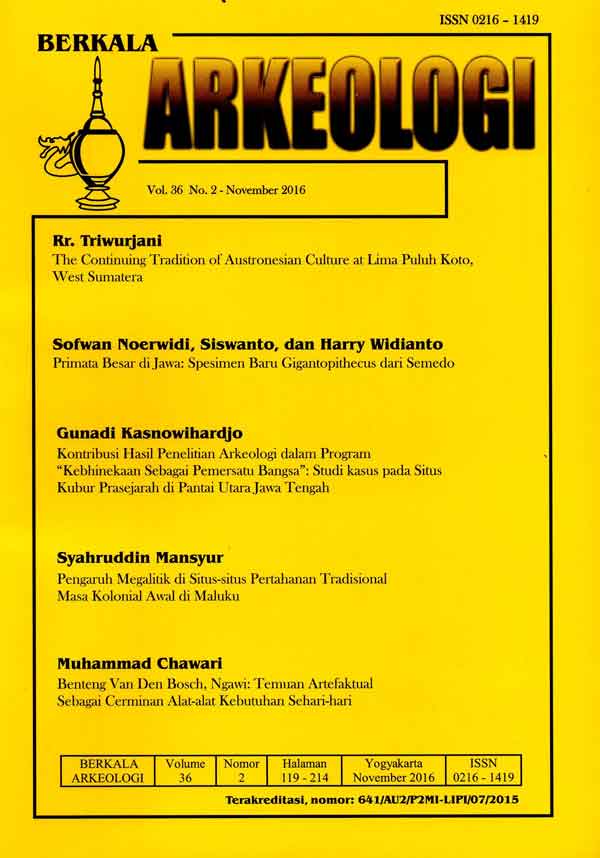KONTRIBUSI HASIL PENELITIAN ARKEOLOGI DALAM PROGRAM KEBHINEKAAN SEBAGAI PEMERSATU BANGSA: STUDI KASUS PADA SITUS KUBUR PRASEJARAH DI PANTAI UTARA JAWA TENGAH
Main Article Content
Abstract
Article Details

This work is licensed under a Creative Commons Attribution-NonCommercial-ShareAlike 4.0 International License.
References
Bellwood, Peter 2006. “Austronesian Prehistory in Southeast Asia: Homeland, Expansion and Transformationâ€, dalam The Austronesians Historical and Comparative Perspectives (edited by: Peter Bellwood, James J Fox and Darrell Tryon), The National University, E-PRESS.
Cole, Sonia, 1970. The Neolithic Revolution, Trustees of the British Museum London, Fifth Edition, Staples Printers Limited.
Geldern, Robert von Heine, 1945. “Prehistoric Research in the Netherlands Indiesâ€, Science and Scientist in the Netherlands Indies, Pieter Honig, Ph.D., New York.
Kasnowihardjo, Gunadi, 2012. “Penelitian Situs Kubur Prasejarah di Pantai Utaraâ€, Laporan Penelitian Arkeologi, Kabupaten Rembang, Jawa Tengah, Balai Arkeologi Jawa Tengah (Belum diterbitkan).
Kasnowihardjo, Gunadi, 2013. “Penelitian Kubur Prasejarah di Situs Leran, Kecamatan Sluke, Kabupaten Rembang, Jawa Tengah, Laporan Penelitian Arkeologi, Balai Arkeologi Yogyakarta, (Belum diterbitkan).
Mahsun, 2008. Pemetaan Bahasa-Bahasa Daerah di Indonesia, Makalah ini disampaikan pada Kongres Internasional IX Bahasa
Indonesia di Jakarta, 28 Oktober – 1 November 2008. https://pondokbahasa.wordpress.com/2008/12/07/pemetaan-bahasa-bahasa-daerah-di-indonesia/
Noerwidi, Sofwan, 2015. “Assessing Population Affinity using Dental Metric and Non-Metric Traits at the Leran Burial Site, Rembang, Central Javaâ€, paper presented on 15th International Conference of The European Association of Southeast Asian Archaeologists, 6-10 July, 2015, Universite Paris Quest Nanterre La Defense (unpublished).
Tryon, Darrell,. 2006. “Proto-Austronesian and the Major Austronesian Subgroupsâ€, dalam: The Austronesians Historical and Comparative Perspectives (edited by: Peter Bellwood, James J Fox and Darrell Tryon), The National University, E-PRESS.
Widianto, Harry dan Simanjuntak, Truman. 2009. Sangiran Menjawab Dunia, Departemen Kebudayaan dan Pariwisata, Balai Pelestarian Situs Manusia Purba Sangiran, Edisi Khusus. ISBN:978-602-95255-0-2
Zoetmulder, P.J. 1983, Kalangwan. Sastra Jawa Kuno Selayang Pandang. pp. 415–437. Jakarta: Djambatan

